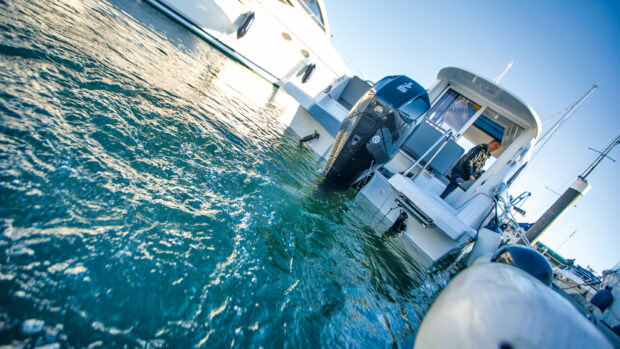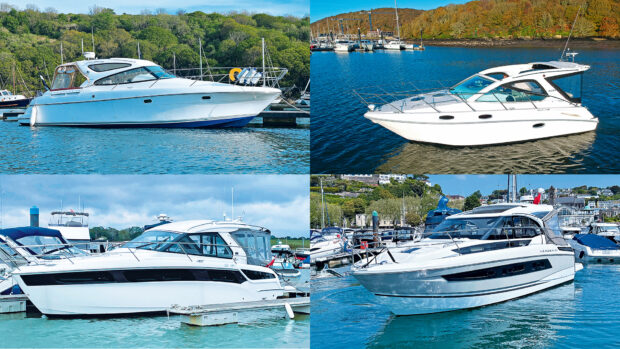It took three different craft and three subsequent refits for classic boat enthusiast David Johnson to realise his dream but the end result is worth every penny…
Having spent most of my childhood weekends and holidays through the 1970s on the Thames or across the English Channel on a Birchwood GT33 fitted out by my father, I got bitten by the boating bug from a very early age.
On one such holiday I vividly remember chugging along at our normal 12 knots and watching two boats reeling us in then passing us at what seemed an unbelievable speed. That was the first time I saw the beautiful Fairey Huntsman.
A spell in the Royal Navy as a marine engineer during the mid-1980s did nothing to lessen my love of boats but it wasn’t until the late 1990s that I could scrape enough money together to buy my first boat.
The brief was quite simple: fast, twin diesel, shaftdrive and good seakeeping. Well, with only £17k it was a very small pond to pick from but I was very pleased to see a Fairey Huntsman 28 in Malta advertised so I booked a flight to view it.
The boat had an interesting history, evidently running night-time smuggling trips to Morocco! Unfortunately, however, the price was not negotiable, which it needed to be to allow for the shipping costs back home.
Article continues below…

Former pro sailor explains how he restored a classic Fairey Swordsman 40

How I refitted a 1980s Fairline Corniche 31 for less than £10,000
Not long after I saw an advert in MBY for another Huntsman in Shamrock Quay, Southampton, and having booked a viewing I found myself standing on the pontoon looking at Playtime 2. I bought the boat on sight despite the worryingly low oil pressure when I ran the engines.
However, having stripped and rebuilt many engines by then, I knew the mechanical work wouldn’t be a problem. Also having done a fair bit of timber work, I was sure that with some expert guidance that wouldn’t be an issue either.
So, at an agreed £16k and with a huge smile on my face, ex-Fairey Marine race boat 333 and Cowes-Torquay class winner Playtime 2 became mine. Eighteen months later and with the engines rebuilt, a lot of repairs to the rotten timber, new electrics, a full repaint and too many hours to count, she took to the water.

David’s first boat, the Fairey Huntsman Playtime 2
There followed many happy weekends around the Solent and a trip to the Channel Islands with a northerly Force 5 return crossing which, although wet and lumpy, proved what a capable boat she was.
By then I needed a bigger boat so I sold Playtime in 2003 and bought a Fairey Swordsman 33 even though she had no engines, shafts, props and several other essentials. However, six months later she was sat on her mooring at the Riverside Boatyard on the Hamble renamed Scimitar with a pair of 320hp Ford Sabres in her that were good for 35 knots.
I have to thank the late Peter Foulkes for all his expert Fairey boatbuilding advice and help with both Playtime and Scimitar, not to mention his friendship – he is sorely missed. His brother Anthony now runs the yard and shares Pete’s generous, friendly character.

His next boat, a Fairey Swordsman 33, needed new engines fitting
Triana time
As good a sea boat as Scimitar was, my partner Helen had never been overly impressed with the slightly basic interior of the Faireys so we decided to look for something more modern.
Helen had visions of a Fairline Targa or Princess V-class but I had other ideas! A call from a boating mate told me there was an original 1976 Triana Tantarella 35 for sale in Weymouth.
In my mind it ticked Helen’s “more modern” box – well the Swordsman was from 1967 – and more importantly it had been designed by the legendary ‘Sonny’ Levi of Surfury, Virgin Atlantic Challenger II and Levi Corsair fame to name but a few.

An original 1976 photograph of his current Triana Tantarella
Apparently she was purchased new for £31,500 and kept in Christchurch but in 1978 the owner was made an offer that he could not refuse and sold her for £42,000, a huge amount of money at the time.
I have since met the second owner’s wife who told me they could have bought several houses for what they paid for it. The boat was then shipped to Malta where it spent the next few years cruising the Med until it was purchased by the fourth owner in 1990 and returned to the UK.
I arranged an urgent viewing. There she was, the boat of my dreams and once again my heart told my brain that I had to have her! Onboard, however, it was clear a huge amount of work was needed to get her to the condition that we wanted.

As David bought her in 2006 complete with mouldy headlining, tatty galley and damp upholstery
To my surprise Helen loved the boat and a few days later a price of £32,000 was agreed subject to a more thorough inspection. I opened up every locker and hatch and with the aid of a torch, toffee hammer, scraper and moisture meter, I inspected every accessible inch of the hull and superstructure.
I sounded the mouldings for signs of delamination, tested the underwater sections for moisture, inspected for osmosis (even though she had been epoxy coated in 1990) and could not find a single problem other than some scrapes and chips to be expected of a 30-year-old boat.
Although structurally sound, to say she needed refurbishing was an understatement. The teak decks were lifting, the rubbing strake was loose, the non-original red Perspex windows were leaking, the interior linings were hanging off and she was full of damp and mould.

The original teak interior had been painted in what looked like red fence paint, the cockpit seats had been binned and the engineroom bilges were awash with an oily sludge. The good news was that the engines had been replaced with new Ford Sabre 225hp units in 1990 and only had low hours. I had found my dream Triana Tantarella at last!
The big refit
In September 2006, my brother and I collected the boat from Weymouth armed with a toolbox, a good supply of fuel filters and our lifejackets. At a stately 15 knots we cruised her back to the Hamble.
Once back at Riverside Boatyard she was lifted and the strip-out began. I had decided to replace pretty much everything including all soft furnishings and linings, the fuel, exhaust and raw water systems, the electrics, windows, teak decks and anything else that was past its best.
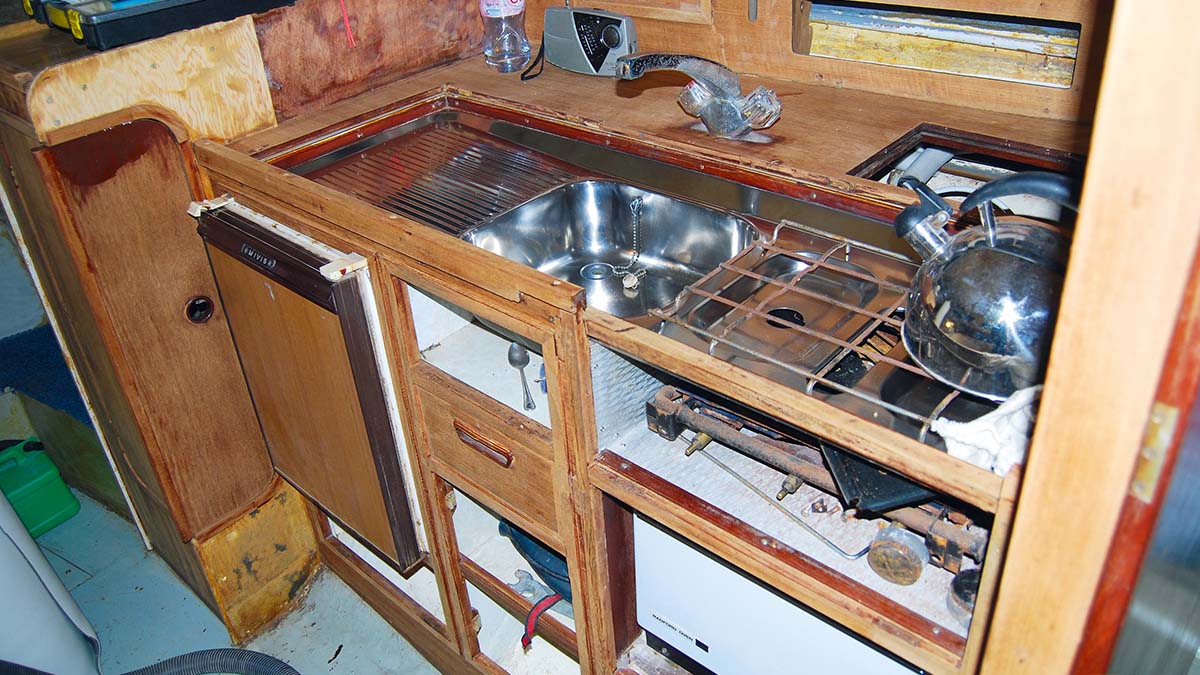
The engines would also come out for a service and repaint. By keeping her under cover, I was able to work on her regardless of the weather and progress was pretty fast, aided at times by my friend Mick, who had tipped me off about her sale, and my brother Keith.
I had decided to sympathetically update the interior by replacing the white vinyl deckhead and cabin side linings but covering the bulkhead linings with teak to give a warmer feel. I changed the galley worktop, appliances and made a new teak unit to hide the crockery storage.
Interior fittings and lights were changed to chrome and new grey Alcantara cushions ordered. The heads were updated with new toilets, showers and taps. The engineroom was stripped, cleaned and installed with new systems for the engines to be refitted and realigned with refurbished props.

Hayling Yacht Company completed a full respray of the superstructure in 2017. The cockpit and windows all had to be carefully covered to avoid any overspray
I rewired the boat and relocated the batteries back to their original position. The red Perspex windows were dumped and new tinted glass windows fitted, bedded in with Arbokol 1000 (a very effective sealant).
Externally, I sanded back the cabin sides, removed and re-bedded the transom hung rudders and bathing ladder and fitted a new stainless steel rubbing strake. Advanced Marine Decking fitted new Flexiteek decks, which look good and are much lower maintenance than teak. New stainless steel cleats, fairleads and a Lewmar electric windlass were also installed.
Need for speed
To get a glass-like finish I asked Max Fenning, a professional boat painter, to paint the cabin sides and transom in Awlgrip red. Most Triana Tantarellas were blue but Super Seahorse was red from new and I think it really suits the boat.

The red superstucture band was returned to its original colour using proper marine paint. The hull was blasted back to the Gelshield and treated with fresh epoxy and antifouling
Years of old antifouling were blasted back to the Gelshield epoxy to which we added two new coats before applying fresh antifouling. After a full survey for valuation purposes and no defects found she finally hit the water in June 2008.
Since then we have had many years of enjoyment with Super Seahorse, including numerous trips to France and the Channel Islands. We have been out in some pretty rough seas and she always inspires confidence, taking it all in her stride and at considerable speed if needed, thanks to her fine entry, constant deep vee and bulletproof build.
In 2017 I had the paintwork redone by Hayling Yacht Company and as the gelcoat was finally showing its age after 41 years I also had the rest of the superstructure painted too. They did a fantastic job.
So did we finally have our dream boat? Not quite! The original Triana Tantarella layup is very substantial, which accounts for the lack of any structural cracking or crazing, but she is very heavy. This means that with the Sabre’s combined 450hp and a bit of mid-season growth, she topped out at only 25 knots.
I wanted to be able to cruise at 30 knots when needed and having worked for Cummins as their UK marine business manager and spoken to sterngear expert Paul Williams at Clements Engineering, there was an obvious solution – a pair of Cummins unstressed, high capacity QSB 6.7 litre engines.
These are available with power outputs up to 550hp but I was restricted by the sterntube diameters being able to run a maximum 35mm diameter shafts.

Work begins on removing the old Sabre engines, cutting out the mounts and fitting new ones for the modern 380hp Cummins QSBs
Paul and I discussed this and calculated that Aquamet 22 high tensile shafts would comfortably do the job but I would need shallow reduction ratio gearboxes to keep the engine torque multiplication down and 3-blade, cupped props in order to meet the required shaft speeds and maximum 18in diameter props.
This resulted in me selecting the 380hp QSB engines with a rated speed of 3,000rpm and ZF 220A gearboxes with 1.235:1 ratio. Cummins UK pointed me to Seapower Marine near Ipswich to do the work and a deal was agreed in April 2021.
When the summer cruising season was over, we had her lifted in October and I rolled up my sleeves once again and set to work removing the Sabres and gutting the engineroom.
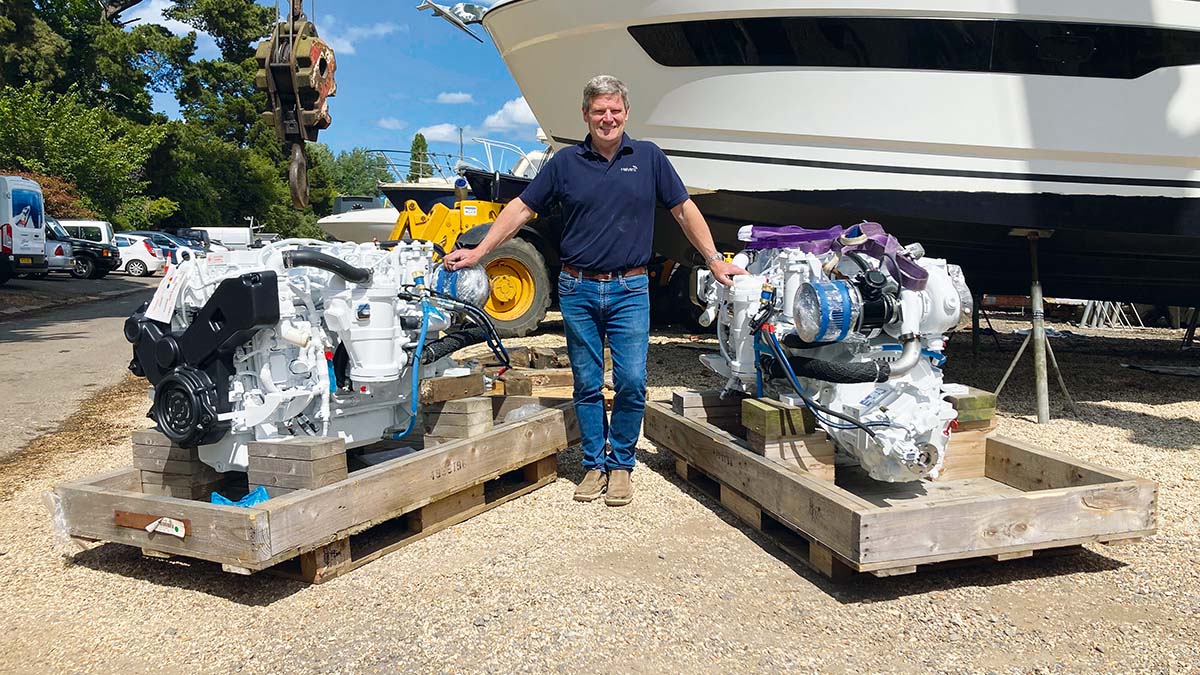
The new engines were going to be a tight fit so I had ordered the Cummins option of slimline, low-profile units. These would fit (just) but as down-angle gearboxes were needed to avoid modifications to the cockpit deck height, it meant the original steel engine beds needed replacing.
As these were bonded and laminated into the longitudinal supports I had to cut and grind them out. Next I took the gelcoat back to the laminations ready for the new engine beds and whilst I was at it decided to remove all of the engineroom gelcoat so I could re-flow-coat it.
I then set the new engine beds on a special 2-pack structural adhesive called Crestomer 1186PA and laminated them over with five layers of biaxial glass cloth and epoxy resin. To allow for the significantly increased exhaust gas flow, I cut and fitted additional 6in diameter GRP underwater exhausts and made epoxy foam-cored external hull venturi profiles.

New engine mounts ready for laminating
This is not straightforward as you need to ensure there is no chance of water entering the engines in any condition and also that the venturi effect works so the engine exhaust back pressure remains within limits.
Luckily I work at Halyard Marine whose core business is the design and manufacture of marine exhaust systems and needless to say they also made the new exhaust systems for me. Lastly, after a final sand and acetone wipe down I flow-coated the engineroom.
To allow for the significant increase in power I then replaced the raw water systems with 2in skin fittings, valves and strainers, and replaced the fuel systems with larger diameter hoses and valves and checked for sufficient airflow to feed what would be close to 800hp.
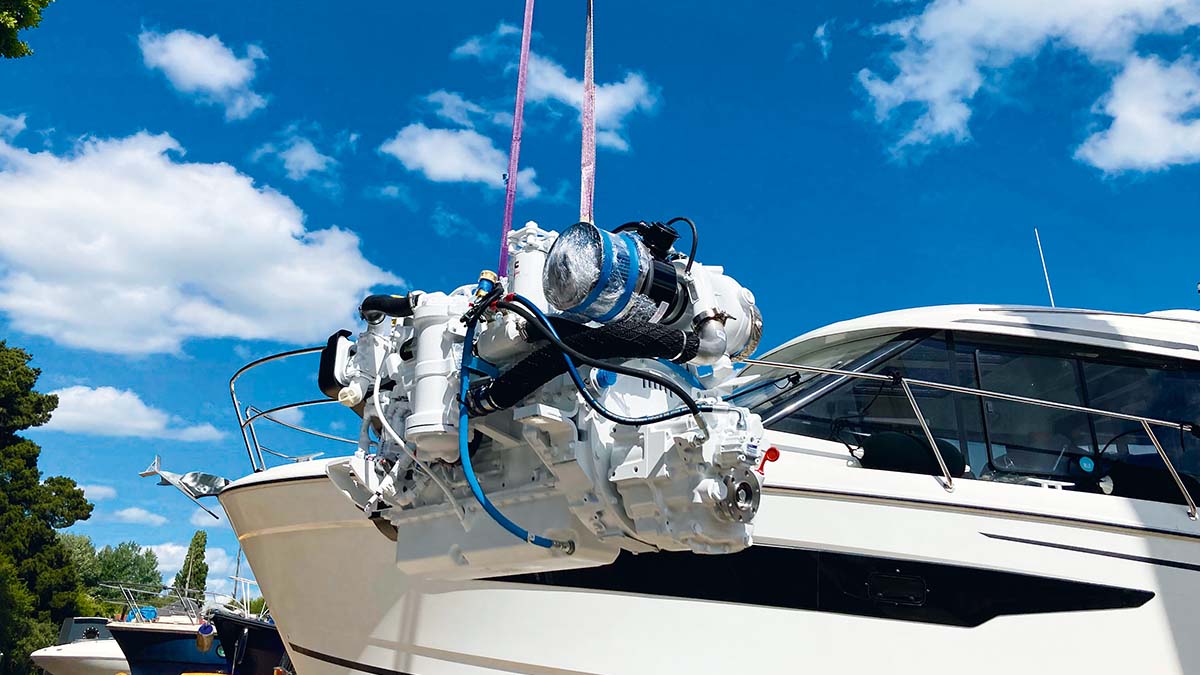
With everything ready Anthony Foulkes fired up his crane and carefully lifted the engines into the boat. I have to admit I was pretty apprehensive about whether they would align correctly with the mounts but my measurements were good and they dropped onto their mounts perfectly.
This left the engine alignment, fitting the props, connecting the engine electrics, which was simplicity itself as the Cummins system is plug-and-play, and fitting the new carbon fibre dash I had made. I finally relaunched her on 19 August 2022 with a huge smile on my face.
Sea trials followed the next week and with Seapower Marine’s approval of the installation and all the engine parameters within Cummins limits, she was good to go. The props needed a final tweak but once sorted she flew up to 36 knots, transforming her ability to cover big distances at speed.

The mighty QSBs are a tight fit but worth it
Sum of its parts
So was it all worth it? Definitely! The re-engining project finished around £5k over budget with some of this down to material increases and some due to the smaller items not captured in my original plan.
I could have done it for a bit less if I had used cheaper materials such as DZR brass fittings instead of bronze for the raw water systems but as I intend to keep the boat for years to come I wanted the best.
Am I pleased with the results? Absolutely! She now has the power and speed that her Levi hull deserves and sporty looks suggest. She leaps onto the plane like a scalded cat and flat-out she behaves perfectly, leaning into the turns safely and predictably.

Super Seahorse now flies along at 36 knots
With the common-rail engines and underwater exhausts she is also much quieter, although there is still a very satisfying note from the original above-water exhaust outlets, needed for when the venturi scoops are not yet drawing.
Apart from the significant improvement in performance Super Seahorse is also future-proofed for a good 20+ years. The good old Sabres never let us down but the new Cummins engines, being to the latest emissions requirements, will also be kinder to the environment. Even on start-up there is not a whiff of smoke from the exhausts.
So what did I learn? That I still love getting stuck into a boat renovation project and that you don’t have to go far to find very helpful, knowledgeable people in the marine industry.
Including the original purchase price, restoration, equipment updates and repower, Super Seahorse has cost me some £120k to date (excluding my time), which I think represents fantastic value for such a fast but also very usable classic.
First published in the June 2023 issue of MBY.

The lower saloon and galley are well set up for cruising duties with friends while the aft cabin layout gives extra privacy for David and Helen

The restored aft cabin and galley are as stylish as they are practical



Flexiteek decking and Alcantara upholstery look modern and are easy to maintain

Sonny Levi hull and styling have stood the test of time remarkably well for a 47-year-old boat







